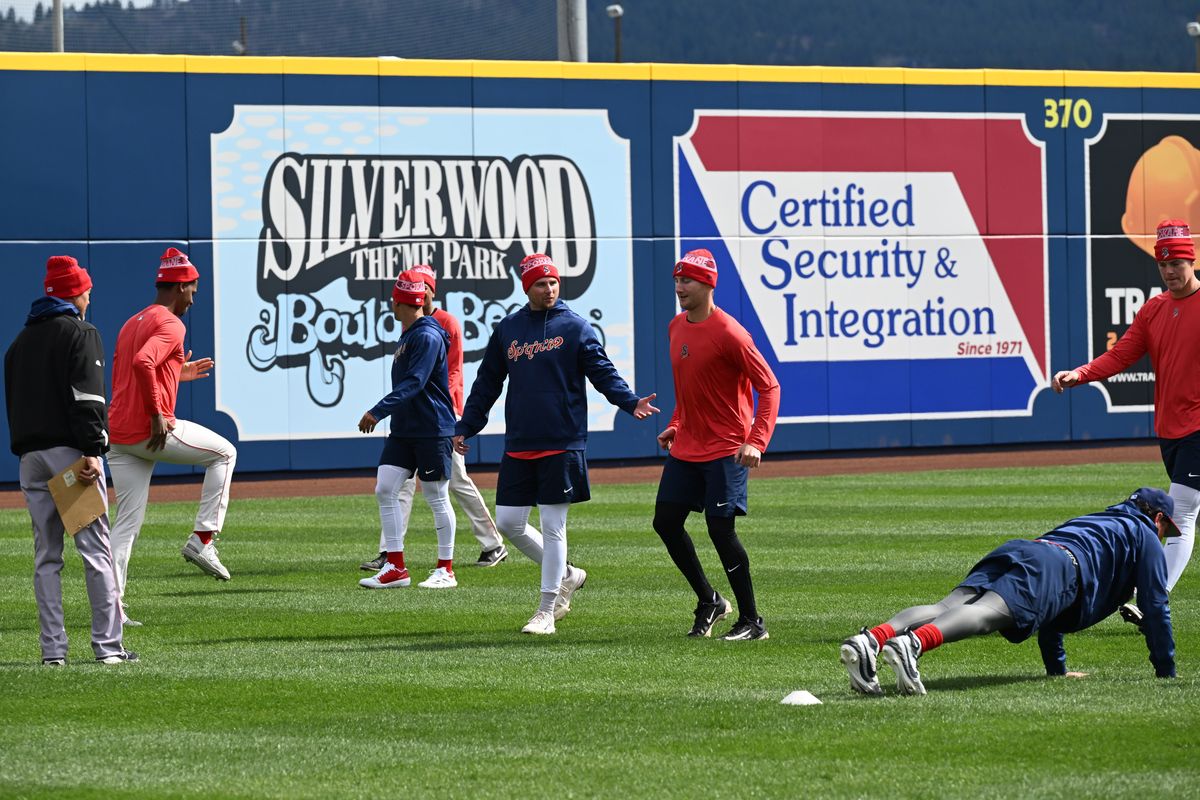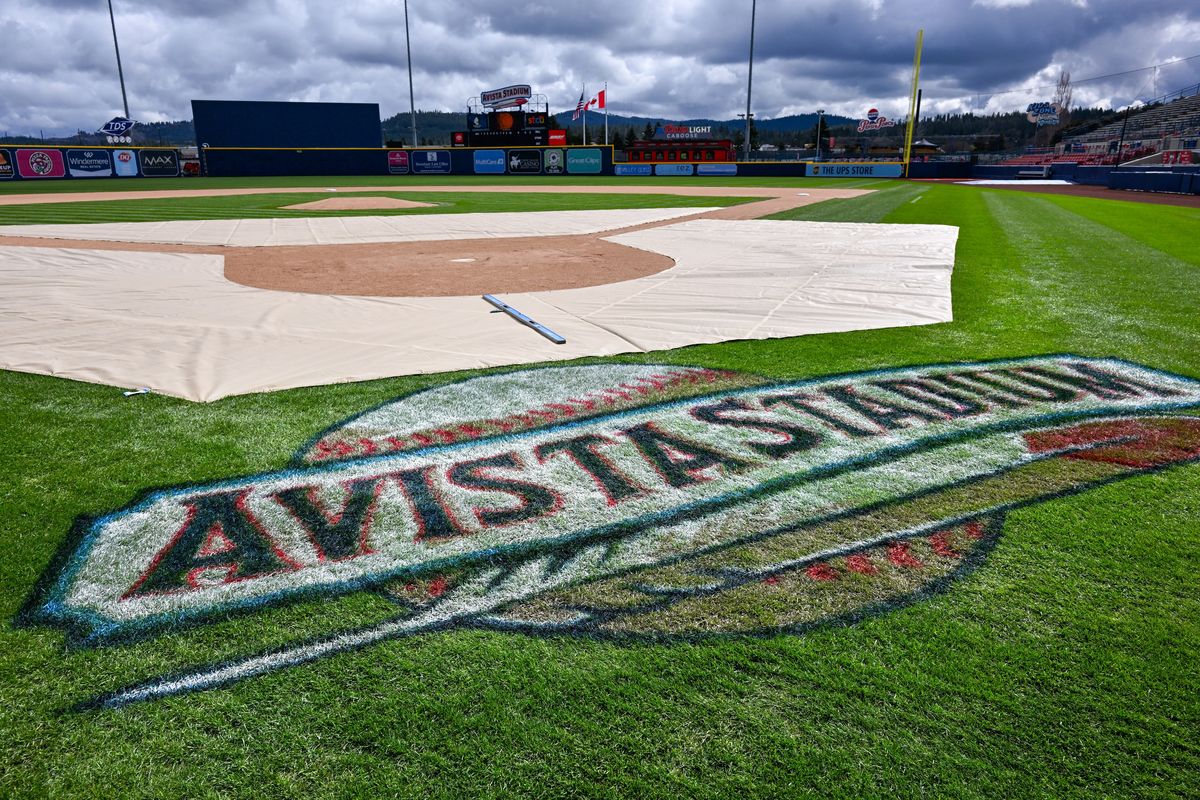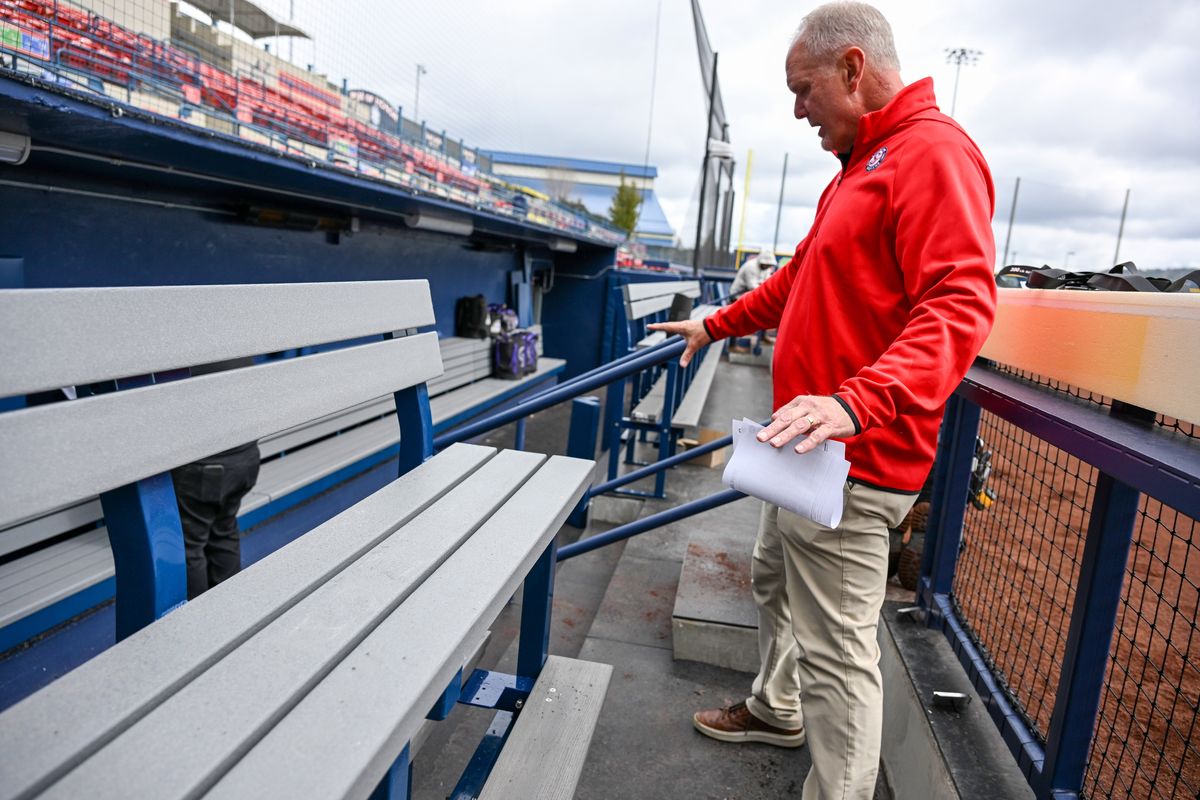‘Phase 2’ upgrades to Avista Stadium, playing surface give venerable facility allure of big leagues
Artist Tom Pettoello painted the logo on the grass at Avista Stadium, the home of the Spokane Indians baseball team, where the team is gearing up for their 2025 season, shown Tuesday, April 1, 2025 in Spokane, Washington. New turf, bigger dugouts, padded outfield walls and other improvement made over the past two years. (Jesse Tinsley/THE SPOKESMAN-REVI)
It has taken several years, and a lot of maneuvering, but the MLB-mandated improvements to 67-year old Avista Stadium are complete.
There is still a wish list of things the Spokane Indians organization would like to do down the road, and a few projects yet to be completed. But the specific conditions MLB required all affiliated minor league baseball organizations to comply with as part of the Player Development Contract each had to sign after the restructuring of the minor leagues a few years ago have been satisfied.
The deadline to complete all of those conditions was Opening Day 2025.
“We are in compliance,” Indians president Chris Duff said.
That’s no small thing. Without those upgrades to the county-owned ballpark – largely to improve the players’ health, safety and development – the organization stood to lose affiliation and the franchise could have been moved to a municipality that would comply, or perhaps contracted altogether.
After voters in Eugene declined to help fund a new stadium last year, the Emeralds announced plans to relocate. They sublet at the University of Oregon’s PK Park, but it does not meet MLB’s standards for minor league facilities. Without a new ballpark, the organization had no options to stay in Eugene.
The Emeralds have been part of affiliated baseball in Eugene since the inception of the Northwest League in 1955.
The Avista Stadium $22 million public-private-funded project will ensure that affiliated baseball stays in Spokane.
“When you think about where we were a few years ago, and losing the 2020 season due to COVID, and the full restructure of the minor league baseball system during that time as well – it’s a lot, you know,” Duff said. “We didn’t see the pathway at that time. We were fortunate enough to get the City of Spokane Valley, Spokane County and state of Washington all pulling the same direction with the team to secure (Avista Stadium) for years to come.
“It’s pretty astounding to think about what we’ve accomplished in a short amount of time. But we’ve got more to do.”
“Phase 1” was comprised mainly of “inward looking” amenities, including renovation and expansion of the home and visitors clubhouses and adding player commissaries, as well as upgraded LED lighting.
“Phase 2” consists of a lot of “fan facing” upgrades, including:
- New, flatter playing surface, irrigation and drainage.
- Expanded dugouts with protective netting and padding.
- Protective netting extending down the foul lines.
- New standard-sized foul poles.
- Padded outfield walls.
- State-of-the-art indoor strength and conditioning facility.
“All of the player amenity components that are required by Major League Baseball have been completed,” Duff said.
“We feel really good. It’s exciting to get some of these projects complete and to have the (players) arrive on Sunday,” Duff added. “It was really neat just see them on the field taking ground balls (on Tuesday). It’s always really nerve wracking the first time you see a ball hit the turf out there, but it looked like we were getting really good hops.”
The field is noticeably more level and no longer slopes down into center field.
“I think fans this year will walk in and they will notice a really nice looking field,” Duff said. “But they’re not out there. They’re not feeling the undulation, seeing the elevation changes.
“It did really stand out to (manager Robinson Cancel) when he walked out and laid eyes on it for the first time. And you can see it, you know, visually that it’s a level playing surface now, where it wasn’t prior.”
The player performance center building beyond the left-field clubhouse holds batting cages and indoor workout areas, a large, state-of-the-art weight room, locker rooms for male and female umpire crews and mascot staging areas.
“The players really seem to enjoy the hitting facility,” Duff said. “I just saw the guys working out in there, and it becomes real. It’s neat to see because 10 months ago it was a grounds crew building and then it turned into a vacant lot.”
“It’s definitely changed for the better,” returning catcher Cole Messina said. “The dugouts are really, really cool. The nets down the line will keep the fans safe. The the indoor facility we get to use to prepare every day is awesome. We can’t be more thankful for the work that’s been done.”
The team has completed its internal audit to ensure Avista Stadium meets or exceeds all of baseball’s requirements. The next step is MLB’s in-person audit, which will happen this summer.
“We’re not ‘officially’ compliant quite yet, but we’ve done everything that we need to do to hit that threshold,” Duff said.
The most obvious upgrade as part of Phase 2 is still in the works and should be completed during the season. The team is installing a 30-foot tall, 70-foot wide video board above the left-center field wall.
For reference, the tall outfield wall in left field is 14 feet tall.
The team’s contractors started drilling the holes for the posts that will support the massive structure on Wednesday. Fans will be able to watch construction during the early part of the schedule and the team hopes that the project will be complete in June.
“We’re really excited about that video board project,” Duff said. “All of these projects, I think it’s positively impacted the fan experience to an extent. Obviously it’s raised the level of play for our team as well. But (the video board), you know, they’re going to see it as a work in progress, and then they’re going to get to experience it once it’s all done.”
The team still hopes for a ‘Phase 3’ to the renovation, the components of which would be outside the requirements of MLB.
Those include renovating and expanding the Champions Club, a new sound system, a retrofit of the existing scoreboard, facelifts to the public restrooms and a renovation of the Parks and Recreation building outside of home plate, which will become the new home of the Indians’ administrative offices.
“Maybe that’s that point we’ll get a chance to sit back and reflect and look at what we’ve accomplished,” Duff said. “But if we can get all of those projects done, I think we’ll be in a really good space for several years to come.”

















